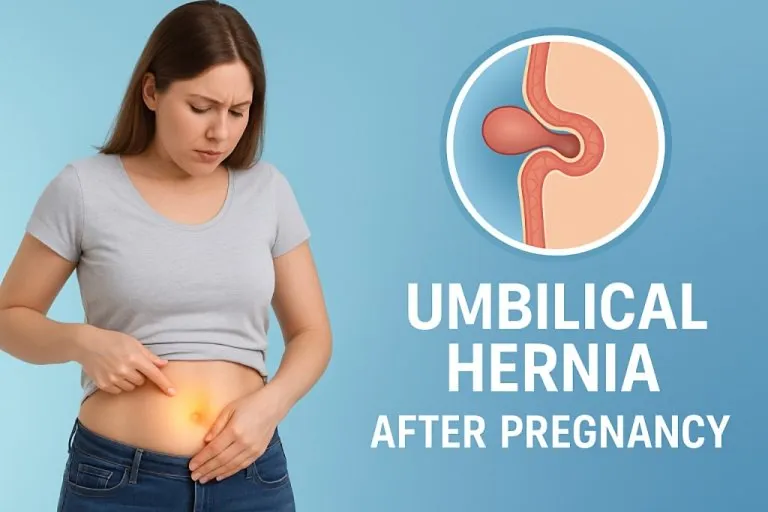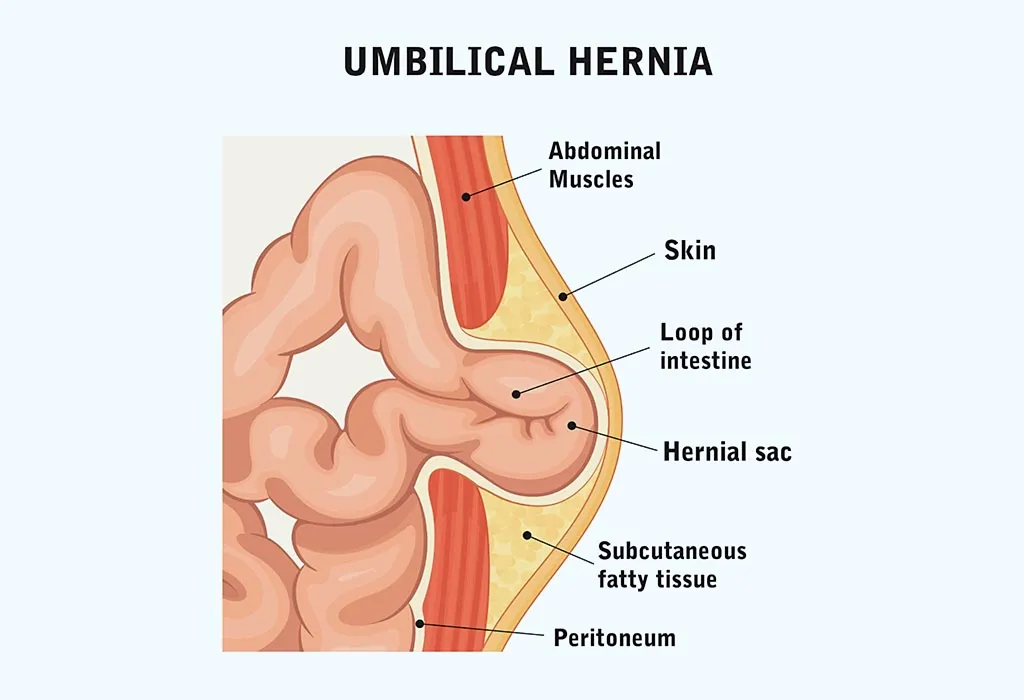Umbilical Hernia After Pregnancy – Causes, Symptoms, and Treatment
Understand umbilical hernia after pregnancy with key symptoms, treatment options, safe exercises, and important care steps.

Welcoming your baby to this amazing world and cradling him in your arms is one of the most overwhelming feelings a woman can experience. Now that you have become a mother and your little one is out, you must be relieved mentally, but your body may not be completely alright. You may feel pain for several reasons, even after your baby is born. One of the reasons for post-delivery pains is an umbilical hernia after pregnancy, which is also known as a postpartum hernia. A hernia can occur anywhere in the body, for example, the thighs, lower abdomen or groin area. But if the umbilical hernia postpartum becomes extremely painful, you need to seek medical attention right away.
What Is an Umbilical Hernia?
An umbilical hernia occurs when the belly button protrudes outward after delivery. It may feel soft and tender to touch, and you may also be able to push it in sometimes. The most common symptom of an umbilical hernia is experiencing strain on the lower abdomen while sneezing and coughing continuously, or even heavy lifting, such as lifting heavy weights (1). Along with experiencing strain, protrusion also becomes prominent. About 0.08% of all pregnancies experience umbilical hernia as well as herniated navel after pregnancy (2). When the hernia is small and asymptomatic, most experts recommend postponing the repair until after childbirth.
Causes of Post Delivery Umbilical Hernia
A postpartum belly button hernia is caused by the excessive pressure built up in the abdomen and pelvic area (3). A few babies have a pre-existing defect in the umbilical region, which becomes apparent when they grow up and become pregnant themselves, leading to an umbilical hernia. Abdominal hernia after pregnancy could also be due to weak abdominal muscles or increased abdominal pressure. The major causes of an umbilical hernia are:
- More than one pregnancy: If you have had twins or conceived twice or three times with a shorter time gap in between, then your muscles tend to weaken, which also triggers the risk of a hernia (4).
- Overweight: If you are overweight, the chances of getting an umbilical hernia are higher, as it weakens the elasticity of your abdominal muscles (5).
- Long hours of labour: A prolonged labour delivery can also lead to an umbilical hernia, as it strains and stretches the abdominal muscles.
- Weak core muscles: If your core muscles are not strong enough, then it might lead to an umbilical hernia. The core muscles support your spine, waist, lower back, and abdomen. So, it is important that these muscles are strong enough to support the body.
- Accumulation of fluid in the abdominal cavity: Accumulation of fluids in the layers of the abdominal wall and abdominal organs may also lead to an umbilical hernia.
- Excessive strain: Straining due to prolonged coughing, lifting heavy weights, or sneezing continuously can also increase the risk of an umbilical hernia.
- Abdominal Surgery: Previously undergone abdominal surgeries or a C-section may also lead to an umbilical hernia (6).
- Genetic Predisposition: Individuals with a family history of umbilical hernias may have a genetic predisposition, making them more susceptible to developing a hernia after childbirth.
- Poor Nutrition: Inadequate intake of essential nutrients and vitamins during pregnancy and post-delivery can contribute to weakened abdominal muscles, increasing the likelihood of an umbilical hernia.
Symptoms of Postpartum Umbilical Hernia
The following are the symptoms of an umbilical hernia that you may witness:
- Mild pain and swelling in your lower abdomen. The pain and burning sensation will increase when you lift heavy weights, cough, sneeze, or have bowel movements. In the case of a strangulated hernia, which causes rigidness and severe pain in the abdomen, you need to get medical treatment immediately.
- You may see visible skin symptoms, such as a hernia on the belly button, develop after a C-section delivery around your abdomen. This type of umbilical hernia after a C-section is called an incisional hernia. The skin on your belly button becomes loose and bulges out. A hernia restricts your blood flow to the intestines, which causes the skin around the affected area to become reddish-blue.
- You may also experience nausea and vomiting when you are affected by a hernia.
- Two of the most severe umbilical hernia after pregnancy symptoms – constipation and the presence of blood during bowel movements may indicate a medical emergency, necessitating prompt medical intervention.
Diagnosis of Umbilical Hernia After Pregnancy
Your physician may examine the protrusion near your belly button. You might be asked to stand and breathe to see if there are any changes in the bulge. Your doctor will also evaluate whether the hernia can be pushed back into the abdominal cavity, review your medical history to determine if it’s strangulated, and create an appropriate treatment plan.
If necessary, you might be recommended to have a blood test to check for infections or imaging studies, such as a CT scan or MRI, to obtain a clearer view of the intestine.
Treatment for Post-Pregnancy Umbilical Hernia
A post-pregnancy umbilical hernia can be treated effectively by surgical means. Some doctors, however, may also suggest non-surgical treatments, which basically include exercising and correcting the posture. Let’s find out which of these umbilical hernia after pregnancy treatment options can provide relief from the condition.
1. Surgical Treatment
Surgical treatment will effectively strengthen the weakened abdominal muscles and reposition the tissues through open surgery (7). Surgical methods include two types: open hernia repair and laparoscopic hernia repair.
Both are done in two ways: mesh repairs and suture repairs. Mesh repairs give better results than suture repairs; repairing with only sutures may cause a recurrence during pregnancy (2).
You may also opt for laparoscopic surgery, which is less painful and more effective with minimal recovery time. The chances of reappearance of a hernia are also less in this case. However, it is highly recommended that, if your hernia is not severe, you perform physical exercises like yoga to strengthen your core muscles.
2. Non-surgical treatment
It might be possible to postpone fixing umbilical hernias that are small, can be pushed back in, and are not causing discomfort (8). The chances of reduction of umbilical hernia are very low with the non-surgical method. However, some doctors may recommend regular exercise like yoga, aerobics, and stretching instead of surgery. Exercising generally strengthens the weaker muscles and could help ease the protrusion back to normal. Performing exercises that do not put excessive pressure on your abdomen and pelvic muscles could give better results. Thus, one may go for breathing exercises, yoga, stretching, cycling, and meditation. Along with regular exercises, maintaining a correct posture is also equally important. You need to be acquainted with how your body functions and come up with stress-relieving techniques. Also, you must refrain from wearing high heels when you are diagnosed with an umbilical hernia, as it puts a strain on the lower abdominal muscles. Standing straight and sitting in an upright posture can also help you correct your posture.
Exercises for Minor Umbilical Hernia After Pregnancy
After pregnancy, some women may experience minor umbilical hernias, and incorporating targeted exercises into their routine can be beneficial in managing the condition. It’s essential to consult with a healthcare professional before starting any exercise regimen to ensure it is suitable for individual cases. The following exercises, when done correctly and under supervision, may help strengthen the abdominal muscles and alleviate symptoms associated with minor umbilical hernias.
1. Pelvic Tilts
Start by lying on your back with your knees bent and feet flat on the floor. Tighten your abdominal muscles and gently lift your pelvis off the ground, creating a slight tilt. Hold for a few seconds and then lower your pelvis back down. Repeat this movement, gradually increasing the number of repetitions as your strength improves. Pelvic tilts engage the core muscles without putting excessive strain on the abdominal area.
2. Transverse Abdominis Activation
Lie on your back with your knees bent and feet flat on the floor. Place your hands on your lower abdomen. Inhale deeply, allowing your abdomen to rise, and then exhale completely, pulling your navel toward your spine. Hold this position for a few seconds before releasing. This exercise targets the transverse abdominis, which is crucial for core stability and can be performed with minimal strain on the umbilical hernia.
Things You Should Avoid
When managing an umbilical hernia after pregnancy, certain precautions can significantly contribute to a smoother recovery. Understanding what to avoid is crucial in preventing potential exacerbation of symptoms and ensuring a conducive healing environment. Here’s a closer look at the key factors to avoid for a more comfortable and effective recuperation.
- Avoid lifting heavy objects, as it can strain the abdominal muscles and exacerbate the symptoms of an umbilical hernia.
- Refrain from performing intense abdominal exercises or those that put excessive pressure on the midsection, such as crunches or sit-ups, as they can worsen the hernia.
- Practice proper lifting techniques, ensuring you bend at the knees and not at the waist to minimise strain on the abdominal area.
- Do not ignore any signs or symptoms of an umbilical hernia, such as pain, discomfort, or a noticeable bulge. Promptly consult with a healthcare professional for proper diagnosis and guidance.
- Avoid straining during bowel movements by maintaining a diet high in fibre and staying adequately hydrated to prevent constipation.
- Opt for loose-fitting clothing to avoid unnecessary pressure on the abdominal region, which can aggravate the hernia.
- If you suspect or have been diagnosed with an umbilical hernia, do not skip medical consultations. Seeking professional advice is crucial for appropriate management and guidance tailored to your specific condition.
What If an Umbilical Hernia Is Not Treated After Childbirth?
You need to be acquainted with the severity of your hernia. If it is very slight and does not cause much discomfort, then it can be left untreated, but regular exercise is a must. However, if you suffer from a severe hernia, then you require immediate medical attention as it can cause serious effects like uncontrollable abdominal pain, and less blood supply to your intestines. Hence, it is advisable to have an open discussion with the doctor before pursuing any kind of treatment or exercises.
How Long Does It Take to Go Away?
When it comes to laparoscopic surgery, you might be able to walk shortly after the procedure, but it could take about three weeks before you can resume other physical activities. A resting period of one to two weeks may be necessary (9). Recovery generally takes longer for open surgery. During your healing phase, it’s essential to avoid intense activities, heavy lifting, and climbing stairs.
The mild to moderate swelling subsides within 4-5 days, and although you may still experience tenderness when touched, you can move around reasonably well.
FAQs
1. Can an umbilical hernia go away on its own after pregnancy?
In some cases, small umbilical hernias may resolve on their own after pregnancy, especially if the abdominal muscles regain strength. However, it’s essential to consult with a healthcare professional for proper evaluation and guidance.
2. Does a postpartum umbilical hernia make your stomach big?
A postnatal umbilical hernia can cause a visible bulge or swelling around the belly button, potentially making the stomach appear larger. This is due to the protrusion of abdominal tissue through the weakened area. However, the severity varies among individuals.
3. What should you avoid eating if you have an umbilical hernia after pregnancy?
While there’s no specific diet for an umbilical hernia, individuals should avoid foods that contribute to constipation, as straining during bowel movements can worsen hernia symptoms. This may include reducing the intake of low-fibre and processed foods, as well as acidic and sugary foods and drinks (10). Instead, increase the consumption of fibre-rich fruits, vegetables, and whole grains. However, it’s crucial to consult with a healthcare professional for personalised dietary advice.
An umbilical hernia after childbirth is a serious medical condition with dangerous effects if left untreated. So you need to consult your doctor even if you do not experience severe pain or discomfort. Prevention of a postpartum belly button hernia is always better than cure. Regular exercising post-delivery and getting back into the correct posture is necessary to keep your body healthy and fit.
Also Read:
Postpartum Oedema
Anemia After Delivery
Joint Pain after Pregnancy
Stomach Pain After Delivery
Hernia After C Section Delivery
Was This Article Helpful?
Parenting is a huge responsibility, for you as a caregiver, but also for us as a parenting content platform. We understand that and take our responsibility of creating credible content seriously. FirstCry Parenting articles are written and published only after extensive research using factually sound references to deliver quality content that is accurate, validated by experts, and completely reliable. To understand how we go about creating content that is credible, read our editorial policy here.
1. https://www.ncbi.nlm.nih.gov/books/NBK459312/
2. Frontiers in Surgery – Umbilical Hernia Repair and Pregnancy: Before, during, after…
3. Michigan Medicine – Treating Postpartum Hernia: What New Mothers Should Know
4. PubMed Central – Current options in umbilical hernia repair in adult patients
5. ALES – Umbilical hernia: when and how
6. JAMA Network – What Is an Abdominal Wall Hernia?
7. NHS – Overview -Umbilical hernia repair
8. American College of Surgeons – Adult Umbilical Hernia
9. Mount Sinai – Incisional Hernias
10. RG Stone Hospital – Healthier Food Options for Hernia Affected Patients
























